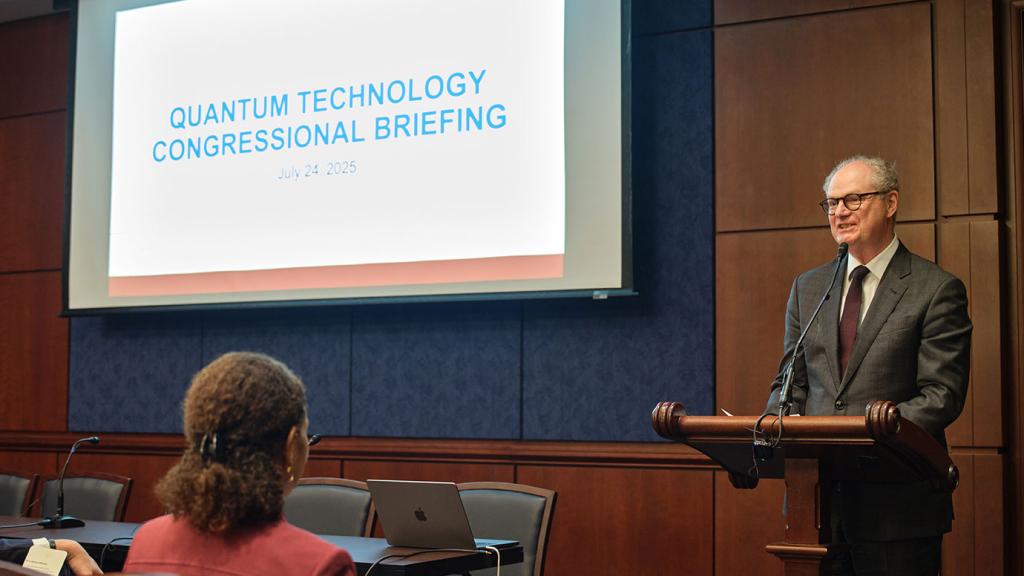There is five times more dark matter in the universe than “normal” matter—the atoms and molecules that make up the familiar world. Yet, it is still unknown what this dominant dark component actually is. On Nov. 11 an international collaboration of scientists inaugurated the new XENON1T instrument designed to search for dark matter with unprecedented sensitivity at the Gran Sasso Underground Laboratory in Italy.
Dark matter is one of the basic ingredients of the universe, and searches to detect it in laboratory-based experiments have been conducted for decades. However, until today dark matter has been observed only indirectly, via its gravitational interactions that govern the dynamics of the cosmos at all length-scales. It is expected that dark matter is made of a new, stable elementary particle that has escaped detection so far.
[view:story=block_1]
“We expect that several tens of thousands of dark matter particles per second are passing through the area of a thumbnail,” said Luca Grandi, a UChicago assistant professor in physics and a member of the Kavli Institute for Cosmological Physics. “The fact that we did not detect them yet tells us that their probability to interact with the atoms of our detector is very small, and that we need more sensitive instruments to find the rare signature of this particle.”
Grandi is a member of the XENON Collaboration, which consists of 21 research groups from the United States, Germany, Italy, Switzerland, Portugal, France, the Netherlands, Israel, Sweden and the United Arab Emirates. The collaboration’s inauguration event took place Nov. 11 at the Laboratori Nazionali del Gran Sasso, one of the largest underground laboratories in the world.
“We need to put our experiment deep underground, using about 1,400 meters of solid rock to shield it from cosmic rays,” said Grandi, who participated in the inauguration along with guests from funding agencies as well as journalists and colleagues. About 80 visitors joined the ceremony at the laboratory’s experimental site, which measures 110 meters long, 15 meters wide and 15 meters high.
There, the new instrument is installed inside a 10-meter-diameter water shield to protect it from radioactive background radiation that originates from the environment. During introductory presentations, Elena Aprile, Columbia University professor and founder of the XENON project, illustrated the evolution of the program. It began with a 3 kilogram detector 15 years ago. The present-day instrument has a total mass of 3,500 kilograms.
Fighting against radioactivity
XENON1T employs the ultra-pure noble gas xenon as dark matter detection material, cooled down to –95 degrees Celsius to make it liquid.
“In order to see the rare interactions of a dark matter particle in your detector, you need to build an instrument with a large mass and an extremely low radioactive background,” said Grandi.
“Otherwise you will have no chance to find the right events within the background signals.”
For this reason, the XENON scientists have carefully selected all materials used in the construction of the detector, ensuring that their intrinsic contamination with radioactive isotopes meet the low-background experiment’s requirement.
“One has to realize that objects without any radioactivity do not exist,” Grandi explained. “Minute traces of impurities are present in everything, from simple things like metal slabs to the walls of the laboratory to the human body. We are trying to reduce and control these radioactive contaminants as much as possible.”
The XENON scientists measure tiny flashes of light and charge to reconstruct the position of the particle interaction within their detector, as well as the deposited energy and whether it might be induced by a dark matter particle or not. The light is observed by 248 sensitive photosensors, capable of detecting even single photons. A vacuum-insulated double-wall cryostat, resembling a gigantic version of a thermos flask, contains the cryogenic xenon and the dark matter detector.
The xenon gas is cooled and purified from impurities in the three-story XENON building, an installation with a transparent glass facade next to the water shield, which allows visitors to view the scientists inside. A gigantic stainless-steel sphere equipped with pipes and valves is installed on the ground floor.
“It can accommodate 7.6 tons of xenon in liquid and gaseous form,” said Aprile. “This is more than two times the capacity we need for XENON1T, as we want to be prepared to swiftly increase the sensitivity of the experiment with a larger mass detector in the near future.”
Aiming for a dark matter detection
Once fully operational, XENON1T will be the most sensitive dark matter experiment in the world. Grandi’s group has been deeply involved in the preparation and assembly of the xenon Time Projection Chamber, the core of the detector. His group is also in charge for the development of the U.S. computing center for XENON1T data analysis via the UChicago Research Computing Center, directed by Birali Runesha, in close cooperation with Robert Gardner and his team at the Computation Institute.
In addition to Columbia’s Aprile, leading the other six U.S. institutions are Ethan Brown, Rensselaer Polytechnic Institute; Petr Chaguine, Rice University; Rafael Lang, Purdue University; Kaixuan Ni, University of California, San Diego; and Hanguo Wang, University of California, Los Angeles.
XEON1T’s first results are expected in early 2016. The collaboration expects the instrument to achieve most of its objectives within two years of data collection. The researchers then will move their project into a new phase.
“Of course we want to detect the dark matter particle,” Grandi said, “but even if we have only found some hints after two years, we are in an excellent position to move on as we are already now preparing the next step of the project, which will be the far more sensitive XENONnT.”






